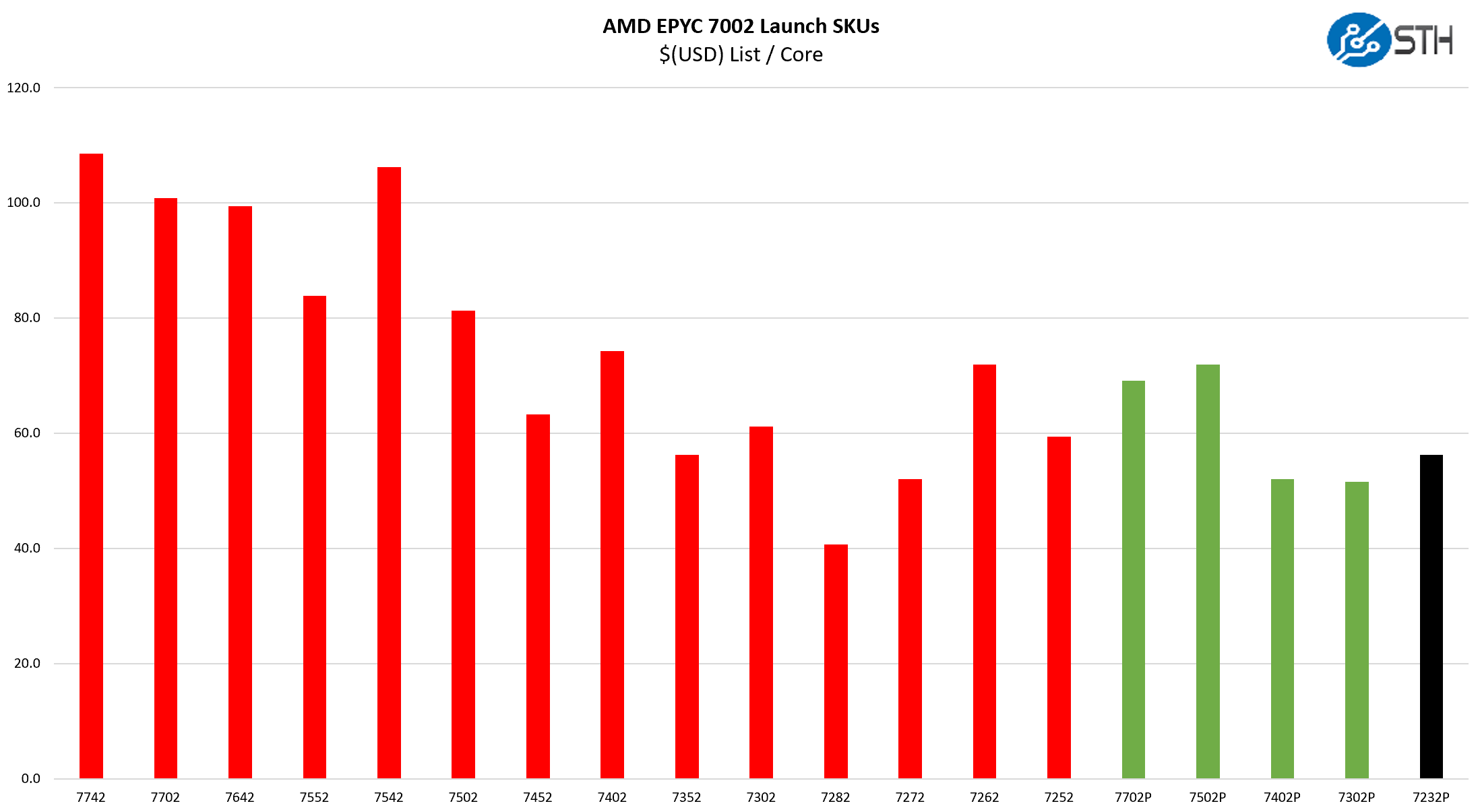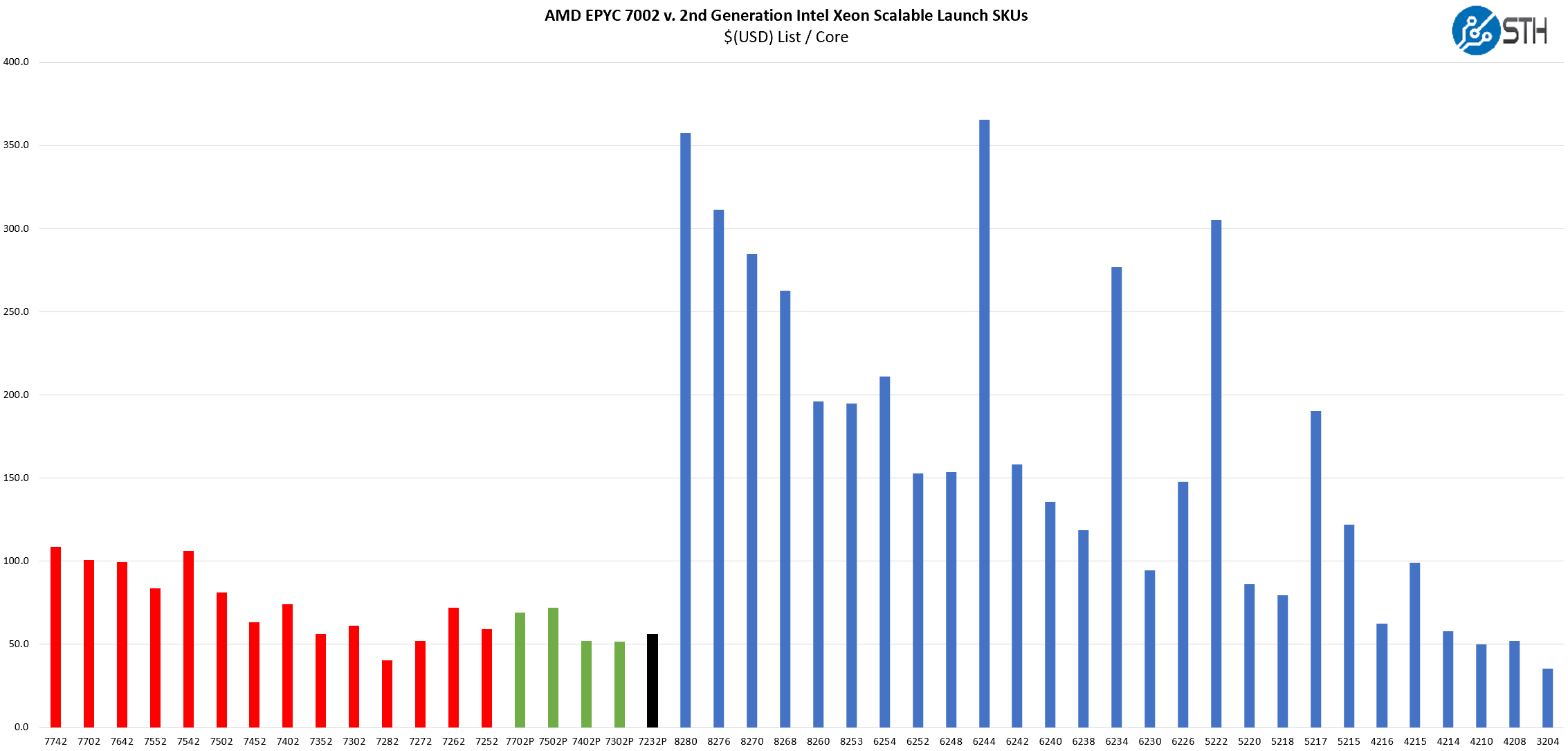AMD EPYC 7232P v. AMD Alternatives
The AMD EPYC 7232PP offers a relatively low cost per core, even for AMD’s lineup as the fourth-lowest-cost CPU by that metric. Here is a quick chart showing where it falls along the overall AMD EPYC spectrum of cost per core.

Perhaps the one item that makes it so hard to recommend the EPYC 7232P is really looking slightly over the horizon. At $825, the AMD EPYC 7302P offers nearly double the performance for what is 20% or less of total system cost. Again, moving to the AMD EPYC 7402P is only a bit more at $1250.
We think the key use case for the AMD EPYC 7232P is to provide minimal CPU power to a system that needs the full use of PCIe I/O. We also expect these systems to have low memory configurations of no more than 128GB (8x 16GB or less.) At the same time, adding too many drives, or too much more RAM can make the ~$400 price differential minimal.
AMD EPYC 7232P v. Intel Xeon Alternatives
Taking a step back, the reason the AMD EPYC 7232P is impactful does not come about just because of its value relative to other AMD EPYC CPUs. Instead, look at it compared to Intel Xeon pricing. You can click the below to go to the attachment page.

Here, the AMD EPYC 7232P is on a per-core cost level alongside the Intel Xeon Silver 4208, Silver 4210, and Silver 4214. As we have seen, the AMD EPYC 7232P is performance competitive with those chips. If you have a server where you need a handful of SATA drives, 32GB of RAM, and will not be using PCIe Gen4, then the race between the Intel Xeon Silver line and the EPYC 7232P is very close.
The catch is going beyond that. Once you need more PCIe lanes, drives connected, higher-end networking then you are really competing two Xeon Silver CPUs to one EPYC 7232P.
In the previous generation, single-socket EPYC was a harder sell. Companies that buy one model of a server with various configuration levels could not replace almost the entire dual Xeon Scalable line with a single CPU. Now, that is possible. That means the same base configuration that will use the EPYC 7232P CPUs can also handle the EPYC 7702P 64-core parts. That is a big deal since it is an asymmetric attack on the Xeon Scalable line.
Intel’s primary advantages such as Optane DC Persistent Memory are not available on these Intel Xeon SKUs that are sub $500. Intel Xeon Silver 4200 SKUs also are supposed to have only single port FMA AVX-512. Xeon Silver has VNNI (DL Boost) but the Intel product marketing team seems to have been more concerned with potential cannibalization of their higher-end segments than competitiveness with EPYC. Intel’s product marketing team opened the window to AMD in this segment due to its de-featuring of lower-end chips.
Final Words
When I wrote the intro calling the AMD EPYC 7232P the king of server CPU squalor it was not intended to last through editing. Yet here we are. One does not buy the AMD EPYC 7232P for all-out CPU performance. What we have seen is that AMD has a competitive single and multi-threaded performance to the point where it is an Intel Xeon Silver competitor, if not a bit faster. Where this chip is focused is not on a head-to-head competition with Intel Xeon Silver for CPU performance. Instead, it is focused on providing a low-cost option in the socket and a “good enough” CPU for an application that uses a lot of I/O instead of compute. The AMD EPYC 7232P is not perfect, but it is the current king of the sub-$500 CPU market.




I get what you’re saying. $375 more for the 7302p’s straight up a better deal
Squalor was one of the funniest ones you’ve had since the channel cobbler line. It’s spot on. The El cheapo servers that are sold in volumes but nobody cares about.
We use Xeon Silver 2 per for ZFS boxes. We’re going to try a 7232P and 7302P now and see how they’re working. If we can use the 7232P that’ll save us so much. Getting more PCIe lanes means more drives attached per controller node
I like the phrase “light the platform” for CPUs like this. You don’t buy it because you need crazy amounts of CPU performance, you buy it because it’s the cheapest CPU that’ll go in the socket and enable all the other platform features you do need, like massive PCIe.
I can see this CPU being used in a lot of NVMe storage nodes.
How did you determine the 7232P has a 4*(2c + 8MB) configuration vs. 2*(4c + 16MB)? This would be the first confirmed Zen part with fractionally disabled L3, and people are bickering about it on Twitter, etc.